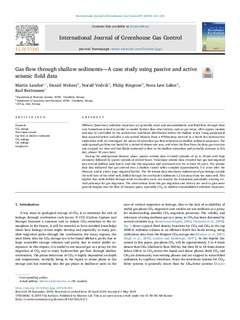| dc.contributor.author | Landrø, Martin | |
| dc.contributor.author | Wehner, Daniel | |
| dc.contributor.author | Vedvik, Noralf | |
| dc.contributor.author | Ringrose, Philip | |
| dc.contributor.author | Løhre, Nora Løw | |
| dc.contributor.author | Berteussen, Karl-Andreas | |
| dc.date.accessioned | 2019-11-29T07:41:30Z | |
| dc.date.available | 2019-11-29T07:41:30Z | |
| dc.date.created | 2019-06-12T21:17:11Z | |
| dc.date.issued | 2019 | |
| dc.identifier.citation | International Journal of Greenhouse Gas Control. 2019, 87 121-133. | nb_NO |
| dc.identifier.issn | 1750-5836 | |
| dc.identifier.uri | http://hdl.handle.net/11250/2630961 | |
| dc.description.abstract | Offshore Quaternary sediment sequences are generally weak and unconsolidated, and fluid flow through these rock formations is hard to predict or model. Surface flow observations, such as gas seeps, often appear random and may be controlled by the architecture and facies distribution within the shallow strata. Using geophysical data acquired before and after a sub-seabed blowout from a 4700m-deep interval in a North Sea hydrocarbon exploration well, we investigate the nature of subsurface gas flow behaviour in shallow sediment sequences. The underground gas blow-out lasted for a period of almost one year, and when the flow from the deep gas reservoir was stopped, we observed that fluids continued to flow in the shallow subsurface and probably continue to this day, almost 30 years later.
During the underground blowout phase, passive seismic data revealed episodes of up to 30 min with high seismicity followed by quieter periods of several hours. Time-lapse seismic data revealed that gas had migrated into several shallow sand layers, and that this migration had continued over for at least 25 years. The seismic data also indicated that gas entered into a shallow tunnel valley complex approximately 1–2 years after the blowout, and at a later stage migrated further. The 3D seismic data also shows indications of gas leakage outside the well bore of the relief well, drilled through the overburden sediments 1.2 km away from the main well. This implies that wells drilled through weak overburden rocks can weaken the formations potentially creating vertical pathways for gas migration. The observations from this gas migration case history are used to gain more general insights into the flow of buoyant gases, especially CO2, in shallow unconsolidated sediment sequences. | nb_NO |
| dc.language.iso | eng | nb_NO |
| dc.publisher | Elsevier | nb_NO |
| dc.rights | Navngivelse-Ikkekommersiell 4.0 Internasjonal | * |
| dc.rights.uri | http://creativecommons.org/licenses/by-nc/4.0/deed.no | * |
| dc.title | Gas flow through shallow sediments - A case study using passive and active seismic field data | nb_NO |
| dc.type | Journal article | nb_NO |
| dc.type | Peer reviewed | nb_NO |
| dc.description.version | publishedVersion | nb_NO |
| dc.source.pagenumber | 121-133 | nb_NO |
| dc.source.volume | 87 | nb_NO |
| dc.source.journal | International Journal of Greenhouse Gas Control | nb_NO |
| dc.identifier.doi | 10.1016/j.ijggc.2019.05.001 | |
| dc.identifier.cristin | 1704490 | |
| dc.relation.project | Norges forskningsråd: 228400 | nb_NO |
| dc.relation.project | Norges forskningsråd: 254748 | nb_NO |
| dc.relation.project | EC/H2020/641943 | nb_NO |
| dc.description.localcode | Open Access. This article is available under the Creative Commons CC-BY-NC-ND license and permits non-commercial use of the work as published, without adaptation or alteration provided the work is fully attributed. | nb_NO |
| cristin.unitcode | 194,63,35,0 | |
| cristin.unitcode | 194,64,90,0 | |
| cristin.unitname | Institutt for elektroniske systemer | |
| cristin.unitname | Institutt for geovitenskap og petroleum | |
| cristin.ispublished | true | |
| cristin.fulltext | original | |
| cristin.qualitycode | 2 | |

